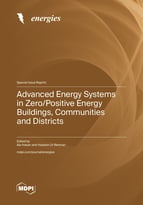Advanced Energy Systems in Zero/Positive Energy Buildings, Communities and Districts
A special issue of Energies (ISSN 1996-1073). This special issue belongs to the section "G: Energy and Buildings".
Deadline for manuscript submissions: closed (25 October 2023) | Viewed by 25941
Special Issue Editors
Interests: energy in buildings and communities; renwable energy integration; simulation and optimization of buildings’ performance
Special Issues, Collections and Topics in MDPI journals
Interests: zero energy building; positive energy buildings; positive energy district; energy transition; energy system modelling; renewable energy systems integration; energy storages; energy flexibility; energy resiliency in buildings and districts; sustainability
Special Issues, Collections and Topics in MDPI journals
Special Issue Information
Dear Colleagues,
The Building sector is important for cities around the world in its Climate Action efforts to reduce greenhouse gas emissions. In general, they are responsible for approximately 40% of the EU’s energy consumption and 36% of the emissions. Therefore, energy in the buildings, communities and districts is one of the main fields for the mitigation of emissions and ensuring a sustainable, self-sufficient and safe future. This can be done by enhancing the energy efficiency and using advanced energy systems components of onsite renewable energy generation, conversion, and storage technologies in buildings, communities and districts, which can offset the imported energy from the grids. Various raising concepts for net-zero/positive energy buildings and districts (NZPEBDs) have emerged in recent years to shape cities in to carbon-neutral communities in the near future. These buildings and districts can also support in reaching self-sufficiency, engage users and provide energy resiliency during outages.
For this Special Issue, authors are kindly invited to submit high-quality papers on one or more of the following topics related to advanced energy systems in net-zero/positive energy buildings and districts:
- Concepts, definitions and KPIs development of nearly/net/zero and positive energy buildings/communities/districts;
- Energy efficiency of buildings in communities and districts;
- Advanced HVAC systems in buildings;
- Heating/cooling energy and electricity demand;
- Advanced short/long-term energy storage for heating/cooling/electricity and controls;
- Renewable-based energy generations and smart controls;
- Energy resiliency of the buildings during grid outages under various weather conditions;
- Energy flexibility offered by buildings, communities and districts to the grid;
- Energy self-sufficiency of the buildings, communities and districts;
- Advanced simulation and optimization methods;
- Experience and results from demos and monitoring sites;
- Economic-, social- and policy-related aspects;
- User’s acceptance and engagement in communities and districts.
Prof. Dr. Ala Hasan
Dr. Hassam Ur Rehman
Guest Editors
Manuscript Submission Information
Manuscripts should be submitted online at www.mdpi.com by registering and logging in to this website. Once you are registered, click here to go to the submission form. Manuscripts can be submitted until the deadline. All submissions that pass pre-check are peer-reviewed. Accepted papers will be published continuously in the journal (as soon as accepted) and will be listed together on the special issue website. Research articles, review articles as well as short communications are invited. For planned papers, a title and short abstract (about 100 words) can be sent to the Editorial Office for announcement on this website.
Submitted manuscripts should not have been published previously, nor be under consideration for publication elsewhere (except conference proceedings papers). All manuscripts are thoroughly refereed through a single-blind peer-review process. A guide for authors and other relevant information for submission of manuscripts is available on the Instructions for Authors page. Energies is an international peer-reviewed open access semimonthly journal published by MDPI.
Please visit the Instructions for Authors page before submitting a manuscript. The Article Processing Charge (APC) for publication in this open access journal is 2600 CHF (Swiss Francs). Submitted papers should be well formatted and use good English. Authors may use MDPI's English editing service prior to publication or during author revisions.
Keywords
- nearly/net/zero and positive energy buildings/communities/districts
- advanced energy systems
- energy resiliency
- energy flexibility
- experience from demo sites
- economic, social and policy aspects
- user’s acceptance and engagement







